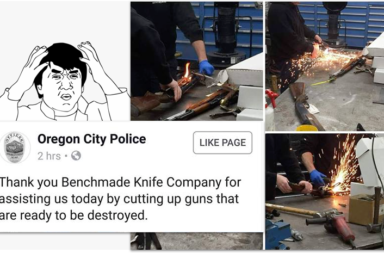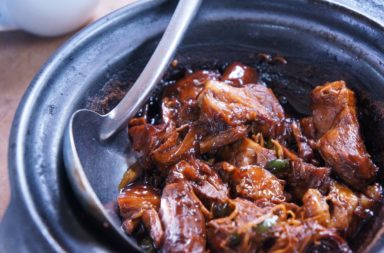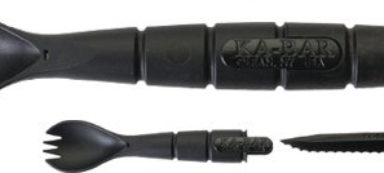The best pocket knife is a somewhat subjective idea. After all, what is best for you, is not best for somebody else. Most people can agree that gas station grade pocket knives emblazoned with cheap symbolism, and impractical blades made of cheap steel won’t qualify as some of the best pocket knives. But there are plenty of other high quality and useful pocket knives out there for most any purpose from hunting knives to tactical pocket knives.
Picking the best pocket knife boils down to cost, quality and end use. Some people favor a traditional knife, others are always chasing the latest and greatest high end blade out there. Here are ten of the best pocket knives we’ve found, and think will serve pretty much any prepper task you might put them to.
The Buck 110
The Buck 110 is a true American icon that features classic styling, warm, comfortable wooden scales and brass bolsters. Add a blade that is useful for everything from common cutting tasks, to butchering a deer, and you’ve got a real winner.
As a best pocket knife contender, the Buck 110 has a lot going for it beyond good looks. First introduced in 1964, this tough, attractive pocket knife has a 3 ¾” stainless blade, and a durable lockback mechanism. So far, so good you are saying, but why is this such a popular knife?
Well for one, it’s been sold for over 50 years. Anytime a product can remain on the market for half a century without any major changes, then you know you’ve got a real winner on your hands. For another, it just looks and feels good in the hand. This is an important aspect of making a trustworthy, and dependable consumer good. Who wants something that looks cheap, and feels flimsy when you operate it? When you use a Buck 110 knife, you know you’ve got a real knife in your hands.
For a prepper, the Buck 110 has a lot going for it. It is reasonably priced, and comes with a fantastic lifetime warranty. It is large enough to use for many common hunting, fishing and camp chores, along with being a decent everyday carry knife. For preppers worried about local knife laws, the 3 ¾” blade is a common legal maximum, and because you can’t simply flip it open with a strong flick of the wrist, you don’t have to worry about being busted for an illegal knife like is an all too common horror stories in places like New York City.
The Buck 110 Isn’t A Tactical Knife Though
Along those same lines, taking out a Buck 110 knife is less likely to freak people out. It is an aesthetically pleasing knife, and the same crowd that thinks AR-15’s are evil guns, while Mini-14’s are not, are also easily pacified at the sight of polished wood and brass. That shouldn’t be a major consideration when purchasing a knife, but it is a practical one.
Buck knives are also famous for their ability to easily take and hold a sharp edge. Due to their unique heat treating processes, Buck makes stainless blades that rival many high carbon steel ones, and give the consumer the added corrosion resistance of stainless steel. For me, this is perhaps the Buck 110’s greatest asset, along with the user friendly design and feel.
Because this knife is a bit larger than a common pocket knife, it ships with a leather belt sheath, which is perhaps the weakest link of the whole system. I personally know too many people who have lost their Buck 110’s out of the sheath when engaged in activity that had them constantly bending up and down in rough brush or jobsites. Despite the weight, I’d either stick it in my pocket, or find a more robust sheath.
On the negative side, there are always things that can be found wrong with a knife, and some things that people just whine about. Common complaints around the Buck 110 include a lack of a thumb stud (get over it folks, this is a workhorse knife, not a whiz bang tactical jobby), lack of serrations on the blade (available from the factory as a custom order), or the fact that it well, isn’t a super fancy tactical blade.
Let’s get this straight. This is not a super fancy tactical knife. Say it with me “The Buck 110 is not a tactical knife.” If you need a tactical knife, or think all knives should fall within the ill defined and nebulous realm of “tactical knife” this isn’t the knife for you. Get over it. For everyone else, this all American made knife is the prepper’s best friend, and a worthy EDC blade. If you don’t own one, you probably vote Democrat and live in California.
The Kershaw Blur
If you are looking for a best pocket knife that happens to be a little more high speed, low drag, then consider the Kershaw Blur.
This Ken Onion designed knife features Kershaw’s SpeedSafe technology, no slip synthetic scales, and a glassbreaker tip in the handle. A partly serrated 3.4” stainless blade rounds out the mix, offering a very nice mix of practical and survival oriented design features that should be at home in the pocket of any prepper.
But why is the Kershaw Blur a contender for best pocket knife? Well, that’s because it offers pretty much all the things you want in a pocket knife that isn’t designed for hunting. All product designs are compromises somewhere, and while you probably don’t want to butcher a deer with a Kershaw Blur, it will do a lot of other things.
Personally, I’m a big fan of assisted opening blades. They are practical, more than a bit fun, and make getting a blade out in tight circumstances or with one hand crazy easy. For a prepper, having a fast opening knife means it is more accessible to you in an emergency, or when you are on the move. Did I mention they are just fun too? Because they are. In fact, my first assisted opening knife was the now discontinued Kershaw Blackout, which I paid top dollar for shortly after it came onto the market. That knife made me fall in love with assisted openers, and Kershaw designs in general.
This Is a Tactical Knife
Making the Kershaw Blur even more useful, is the partly serrated blade which is great for cutting rope, seatbelts, or anything else you need to quickly and roughly cut your way through. When you consider the Blur also features a built in glass breaker tip, then you can see how this is a must have knife in your emergency car kit. It could literally help you free yourself if you are trapped inside your car after an accident.
On the more tactical side of things, an assisted opening knife can turn a tool into a self defense weapon. Now I’m not a big fan of pocket knives as defensive weapons. I see them more as a last ditch tool, but the topic of defensive knives brings up strong responses, so I’ll just leave it with the fact I prefer my pistol to my knife if I have to defend myself.
However, I have used a Kershaw knife defensively when I was stuck living in San Diego. Denied basic self defense rights, I couldn’t carry a pistol, and I worked in a crappy, crappy neighborhood. Having that fast opening Kershaw served as a deterrent to a once determined crackhead who thought I looked like an easy mark as I walked away from the trolley stop.
Kershaw makes great blades, at great prices, and you can use them for everything from opening up a bag of snacks to chasing of crackeads. To me, that makes them one of the best pocket knives out there.
Gerber Paraframe
Around the same time I was chasing junkies off with a Kershaw Blackout, I also had a Gerber Paraframe in my bag. “Why look at Mister two knives over there” you might smirk. But that tough little all stainless knife also was dear to my heart.
We already know a Gerber would appear on a list of candidates for best pocket knife, because Gerber makes really nice pocket knives. The Paraframe is a unique design that features a skeletonized handle that also incorporates the blade locking mechanism into the handle design, which minimizes moving parts and simplifies operation. And that’s why it was in my bag.
The Kershaw was my crackhead-be-gone blade, but the Gerber was the one I used for daily tasks, reasoning if something happened and I damaged or lost my knife, I’d rather it be the strictly utilitarian one.
The clever prepper will immediately notice the many distinct advantages of the Gerber Paraframe. Not only is it lightweight, but the ergonomic handle makes using the knife itself rather easy. The blade is partly serrated, and performs all the common cutting tasks you might expect from a blade that size. Again, I wouldn’t want to be gutting a deer with it, but I suppose you could if you had to.
The Ultimate Knife?
The downside to the Gerber Paraframe is the open handle design. You’ll eventually get a fascinating collection of lint and mystery fibers in your knife, although the design is pretty much self cleaning, so that is a plus.
This is a knife I’d consider as a basic everyday carry simply because it is lightweight, and the pocket clip makes it easy to carry. The lockup is very secure, and the blade holds an excellent edge, so as long as you aren’t abusing it, the Gerber Paraframe will give you great service for a long time.
It would also make a great addition to your favorite bugout bag, due to the lightweight, corrosion resistant design. Is it the Ultimate Pocket Knife(™)? Probably not. Is it one you can use every day for years on end and know you can count in it? Yeah. It’s that.
Columbia River Knife and Tool M16
Another best pocket knife choice, the CRKT M16 comes in a number of different configurations, including partly serrated blades, tanto blades, and several different blade lengths. What makes the CRKT M16 so great is the unique combination of Teflon bearings, an automatic liner lock safety, and a unique Kit Carson designed “flipper”, that makes this knife open almost as fast and easy as an assisted opener. Possibly easier in some cases.
I’ve owned several of these knives, and have always enjoyed using and carrying them. The sleek designs are appealing, but it’s the safety and design features I love the best. A prepper looking for a best pocket knife will appreciate the liner lock safety which prevents accidentally unlocking the knife while in use, and possibly closing the blade on your hand.
With a little practice, using the safety is crazy easy and simple, making this a great knife for children who are learning knife safety skills.
Ergonomics Win Out
The first time I ever picked up a CRKT M16, it was the Teflon bearings combined with the unique flipper design that sold me. Never before had I encountered such a smooth opening knife. If you value being able to quickly open your pocket knife with a flick of the thumb or finger, then you’ll love the CRKT M16.
One of the bigger drawbacks to the M16 is that many of the blade designs are narrow. While this is fine for most common cutting chores, it does create a blade that lacks the “heft” you might want for off grid knife use. However, some of their tanto blade models offer a stouter design that will hold up to a rougher sort of work than their basic tapered blade. If you need a stouter knife along the lines of the M16, consider the CRKT M21 series.
Heavy duty, take into the woods as your only knife, these are not. But as a defensive knife, basic everyday carry, and basic cutting tool, there are worse knives out there. There are better ones too, but for a tactical and practical blade rolled into one, it’s tough to beat the CRKT M16.
Opinel Carbon Steel Locking Knife
To be a best pocket knife, a knife should sometimes be simple, effective and to the point. The French made Opinel knives fit that description, and have been popular for over a century.
I’ve owned and carried Opinel knives for years. The simple design of a high carbon blade, wooden handle, and twist locking ring is quite satisfying. It also fits the prepper ethos of keeping tools simple, while also being highly functional.
Because they use a high carbon blade, Opinel take an edge very well – in fact, I’ve sharpened mine on rocks before just fine. Useful for any task you might need a common pocket knife for, these blades are also good for the prepper. Perfect for cleaning small game and fish, they also serve well as utilitarian kit. Plus if you are going for minimalist you can use them as table knives (after cleaning them of course!) I even saw a blood covered one in Seattle that had been used as a weapon.
Well, They Are French After All
However, there are a few downsides to the Opinel pocket knife. For starters, they rust. That is a fact of life with carbon steel blades (although you can get stainless Opinel knives), and the Opinel is pretty basic in its metallurgy. Sometimes even being carried in the pocket on a hot day is enough to get the rust setting in.
Second, the wooden handle can sometimes swell and make opening/closing the blade difficult. This isn’t a real problem, and something that can be handled with a couple drops of lubricating oil. Its still pretty annoying at times though.
Lastly, these aren’t super tough knives. They are cutting tools, not stabbing tools, chopping tools, or walk naked into the woods with just one tool kind of tools. But they are good knives within the realm of how they were designed to be used. For most Americans, that is plenty, and all they’ll ever need from a knife. But for the off gridder, prepper, or person assembling a bugout bag, there are tougher, stouter knives that can be added to your kit.
But for the price, if you need a basic EDC blade, you’ll enjoy them.
Spyderco Efficient
Spyderco knives have a cult following, albeit for good reason. They certainly deserve to be considered in a search for the best pocket knife. Sadly, they are also ones I have little personal experience with, mostly because I don’t like how they fit in my hand. However, due to an injury, my experiences are something of an outlier, so don’t dismiss these fine knives.
The Spyderco Efficient is well named, because it is, ummm… efficient. Efficient in design, efficient in construction, and efficient in use. Oh yeah, it’s efficient on the pocketbook too, and priced to be very competitive with other top brand knives.
Spyderco design is immediately recognizable, and also commonly copied. The use of sweeping curves, and a simple hole in the blade for one handed opening establish a unique design that tells you who made the knife before you even see the brand on it. Combined with high quality workmanship and top notch blade construction, and you’ve got a rugged, simple knife that will last you for decades.
Simple, Even Efficient
In fact, it is that enduring, rugged simplicity that makes Spydeco knives, and the Spyderco Efficient so great. Preppers should avoid over complex gear whenever possible, and while pocket knives are simple tools, all sorts of complex crap has been piled on them in the name of chasing market share.
Spyderco does away with all that and offers you a no frills, no gimmicks blade that you can take to hell and back without any worry. Long popular with law enforcement, military, and skillful preppers, you’d be making a big mistake to at least not look closely at Spyderco knives when choosing a pocket knife.
On the other hand, if you are after some sort of rugged monster beast of a knife, these probably won’t do it for you. But then again, if that is your end goal, you probably should buy a fixed blade knife.
Conclusion
There are a lot of pocket knives for preppers out there. There are a lot more contenders for best pocket knife out there. You probably won’t agree with all my choices, and might even complain that I left your favorite knife out. Yup, I probably did, and for the simple reason of logistics and personal experience. Each and every knife I’ve written about here are ones I’ve at least handled and used to some extent, and usually have owned.
In other cases, I didn’t choose a given knife out of plans for future articles, or just because it didn’t cross my mind. In the near future, we’ll be writing about classics like the Victorinox Swiss Army Knife, and the Schrade Old Timer. I wanted to put classic non locking, knives into their own articles, sometimes as standalone pieces on a given knife.
Choosing the best pocket knife is tough, and impossible for me to define what that means for you. Some preppers want a do everything pocket knife, while others just want a blade that they can use to cut open packets of freeze dried food. In the middle are all manner of blades that will generally do the jobs they are advertised for, and the tasks you put them too.
Maybe that’s why so many of us have multiple knives. Why limit yourself to just one, when there are so many different good ones, and so many different uses they are optimized for. Isn’t capitalism great?


